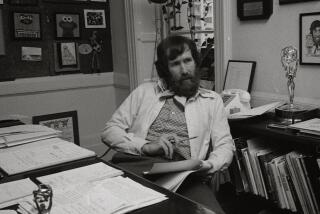Can’t keep He-Man down
- Share via
In 1983, a blond man raised his sword, declared, “I have the power!” and transformed himself into the muscular superhero He-Man. Boys cheered the animated series and children’s advocates hit the ceiling.
Twenty years later, a new version of “He-Man” is back on Cartoon Network, and no one seems to mind.
“He-Man and the Masters of the Universe” scored a big hit in first-run syndication, winning a 16 to 18 share of children in the 2-to-11 age group. And in the stores, more than $500 million worth of toys plus an additional $500 million in related merchandise was sold by 1985.
The program served as a lightning rod for watchdog groups who complained it was just a 30-minute toy commercial. In 1983, Peggy Charren, president of Action for Children’s Television, said, “The over-commercialization of children’s television is worse than that of adult television. A show composed of commercials is insidiously horrible.”
Frank Orme, president of the National Assn. for Better Broadcasting, asserted, “The program was created to sell the product; it wasn’t created to entertain. Without the tie-in for Mattel, the program wouldn’t exist at all. It’s pure commercialism right straight through.”
Broadcasters, animators and toy companies responded with equal vehemence. Dennis Marks, creative director at Marvel, replied, “Wasn’t the Disney show a huge promotion for Disneyland? And how is animating GI Joe different from a guest on Johnny Carson plugging a book or a movie? You can’t condemn one aspect of it without condemning the entire system. TV is one big promotion.”
Twenty years later, where has all the controversy gone?
The decision to revive “He-Man and the Masters of the Universe” was at least partially a response to the continuing requests of fans, says Sam Register, senior vice president of content development for Cartoon Network.
“There’s been a sort of grass-roots campaign to get ‘He-Man’ back on,” Register says. “We got letters, we got calls, we got e-mails. Finally, we said, ‘Let’s look into this.’ People between the ages of 23 and 29 or 30 who grew up on it are the hard-core fans who were clamoring for it.”
“He-Man is one of those characters who survived even after we stopped making toys. There are hundreds of Web sites for fans and people who collect He-Man memorabilia,” agrees Sara Rosales, Mattel vice president of public relations. “During the ‘80s, He-Man was one of the biggest brands here at Mattel, and there’s a huge ‘80s retro phenomenon in pop culture. So we thought we would release a new He-Man line to commemorate the character’s 20th anniversary.”
New generation, new look
The characters have been redesigned for a new generation of kids. Prince Adam has traded his familiar pageboy for a more tousled look. He was never the sharpest sword in the armory, but the new Adam sounds like a laid-back Valley dude. The original He-Man action figure looked like a round-faced caricature of a bodybuilder; the new version has a more chiseled face and sharply defined muscles, changes that are reflected in the animation by Mike Young Productions. (Filmation, the studio that did the original series, closed in 1989.)
“Action cartoons, even when they’re very successful, have a shorter shelf life than comedy cartoons. When you replay even a successful show, it may do well for a short time, but it doesn’t hold up against all the other stuff that’s out there,” says Register. “So we not only had to update the stories to make them competitive with what kids are currently watching, we had to change the look of the characters and the style of the action to make them more compelling.”
Initially “He-Man” was drawing solid ratings on Cartoon Network. Rosales adds, “The toys are selling phenomenally well; Castle Grayskull, which is our big holiday item for the year, has been doing well. So we think that the timing was right on the money to bring He-Man back.”
Is the program still just a 30-minute toy commercial?
“I think if you watch an episode, you don’t look at it and say, ‘This is a commercial for a toy.’ These are nice little films,” says “He-Man” executive producer Bill Schultz. “But let’s face it, there isn’t a successful children’s show on the air that hasn’t spawned some sort of broad-based licensing program, right down to ‘Blue’s Clues.’ I think the tolerance comes from the acceptance that kids get their entertainment from everywhere, and that tolerance will continue as long as we remain responsible and produce a show you can watch without feeling it’s just a commercial.”
Like many other watchdog groups, Action for Children’s Television no longer exists. But Charren remains an outspoken advocate for children’s causes. Reflecting on differing reactions to the two versions of “He-Man,” she commented in a recent telephone interview.
“Parents were never that focused on the advertising itself or the programs that were toy commercials; they were really concerned about sex and violence,” she concluded. “Today, there are lots of other places for commercials to hit children -- and adults too.
“Initially, it was something we only did to kids, because we were afraid adults would turn off the shows. We didn’t have program-length commercials for adults, but we do now. In TV shows and feature films, everything the actors touch represents a paid spot; there’s commercialism in schools now. I think that’s much more objectionable than ‘He-Man’ on TV.”
More to Read
The biggest entertainment stories
Get our big stories about Hollywood, film, television, music, arts, culture and more right in your inbox as soon as they publish.
You may occasionally receive promotional content from the Los Angeles Times.










